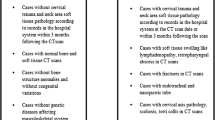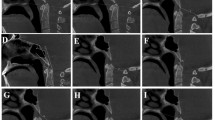Abstract
The atlantodental interval has been usually used for the evaluation of atlantoaxial instability. However, the asymmetry of the lateral atlantodental interval is occasionally found in healthy individuals. Controversy therefore exists as to the clinical significance of this asymmetry in patients after trauma. The purpose of this study was to determine the normal range of atlantodental intervals in normal individuals using reformatted computed tomography. In this study, C1–C2 vertebrae were imaged in 230 adult patients by a Lightspeed Vct CT (General Electric, CT, USA) with a slice thickness of 0.625 mm. After reformatting the original images, the anterior atlantodental interval (AADI) and lateral atlantodental interval (LADI) were measured. The AADI was found to be 1.83 ± 0.46 mm (0.9–3.4 mm) in males and 1.63 ± 0.43 mm (0.5–3.2 mm) in females. The AADI was significantly greater in males than in females (p < 0.05). The 95% confidence interval for AADI was 1.75–1.90 mm in males and 1.54–1.72 mm in females. No statistically significant differences were found between males and females in the left and right LADI, and LADI asymmetry. The left LADI was found to be 3.38 ± 0.87 mm (1.7–6.0 mm), and the right LADI was 3.42 ± 0.84 mm (1.7–5.9 mm) in males, while the left LADI was 3.30 ± 0.73 mm (1.5–5.3 mm) and the right LADI was 3.37 ± 0.92 mm (1.7–5.9 mm) in females. The 95% confidence interval for left LADI was 3.23–3.52 and 2.94–3.25 mm, and for right LADI was 3.27–3.56 and 3.18–3.56 mm in males and females, respectively. The mean asymmetry of LADI was 0.76 ± 0.66 mm (0.0–3.5 mm) in males and 0.73 ± 0.70 mm (0.0–3.7 mm) in females. The 95% confidence interval for LADI asymmetry was 0.65–0.87 mm in males and 0.59–0.88 mm in females. Most of the population was found to have an asymmetry ranging between 0.1 and 2.0 mm. The current study shows that LADI asymmetry is common in patients without any cervical spine abnormalities. LADI asymmetry may be a normal anatomic variant and there is no evidence to confirm that LADI asymmetry is a sensitive or specific indicator of traumatic atlantoaxial instability. Radiologists and clinicians should be aware of this normal range of asymmetry when interpreting CT scans of the atlantoaxial region.


Similar content being viewed by others
References
Ajmal M, O’Rourke SK (2005) Odontoid Lateral Mass Interval (OLMI) asymmetry and rotary subluxation: a retrospective study in cervical spine injury. J Surg Orthop Adv 14:23–26
Deliganis AV, Baxter AB, Hanson JA et al. (2000) Radiologic spectrum of craniocervical distraction injuries. Radiographics 20 Spec No:S237–S250
Diaz JJ, Aulino JM, Collier B et al (2005) The early work-up for isolated ligamentous injury of the cervical spine: does computed tomography scan have a role? J Trauma 59:897–904
Duan S, Ye F, Kang J (2007) Three-dimensional CT study on normal anatomical features of atlanto-axial joints. Surg Radiol Anat 29:83–88
Duan SY, Lin QC, Pang RL (2004) Application of CT 3D reconstruction in diagnosing atlantoaxial subluxation. Chin J Traumatol 7:118–121
Dugailly PM, Sobczak S, Sholukha V et al (2010) In vitro 3D-kinematics of the upper cervical spine: helical axis and simulation for axial rotation and flexion extension. Surg Radiol Anat 32:141–151
Dumas JL, Thoreux P, Attali P et al (1994) Three-dimensional CT analysis of atlantoaxial rotation: results in the normal subject. Surg Radiol Anat 16:199–204
Ellis GL (1991) Imaging of the atlas (C1) and axis (C2). Emerg Med Clin North Am 9:719–732
Fielding JW, Hawkins RJ (1977) Atlanto-axial rotatory fixation. (Fixed rotatory subluxation of the atlanto-axial joint). J Bone Joint Surg Am 59:37–44
Gale SC, Gracias VH, Reilly PM et al (2005) The inefficiency of plain radiography to evaluate the cervical spine after blunt trauma. J Trauma 59:1121–1125
Harty JA, Lenehan B, O’Rourke SK (2005) Odontoid lateral mass asymmetry: do we over-investigate? Emerg Med J 22:625–627
Hinck VC, Hopkins CE (1960) Measurement of the atlanto-dental interval in the adult. Am J Roentgenol Radium Ther Nucl Med 84:945–951
Iannacone WM, DeLong WG Jr, Born CT et al (1990) Dynamic computerized tomography of the occiput-atlas-axis complex in trauma patients with odontoid lateral mass asymmetry. J Trauma 30:1501–1505
Klimo P, Ware ML, Gupta N et al (2007) Cervical spine trauma in the pediatric patient. Neurosurg Clin N Am 18:599–620
Lee S, Joyce S, Seeger J (1986) Asymmetry of the odontoid-lateral mass interspaces: a radiographic finding of questionable clinical significance. Ann Emerg Med 15:1173–1176
Mirvis SE (1998) How much lateral atlantodental interval asymmetry and atlantoaxial lateral mass asymmetry is acceptable on an open-mouth odontoid radiograph, and when is additional investigation necessary? AJR Am J Roentgenol 170:1106–1107
Monu J, Bohrer SP, Howard G (1987) Some upper cervical spine norms. Spine 12:515–519
Roberge RJ (1991) Facilitating cervical spine radiography in blunt trauma. Emerg Med Clin North Am 9:733–742
Roche CJ, King SJ, Dangerfield PH et al (2002) The atlanto-axial joint: physiological range of rotation on MRI and CT. Clin Radiol 57:103–108
Rojas CA, Hayes A, Bertozzi JC et al (2009) Evaluation of the C1–C2 articulation on MDCT in healthy children and young adults. AJR Am J Roentgenol 193:1388–1392
Sutherland JP Jr, Yaszemski MJ, White AA 3rd (1995) Radiographic appearance of the odontoid lateral mass interspace in the occipitoatlantoaxial complex. Spine 20:2221–2225
Wortzman G, Dewar FP (1968) Rotary fixation of the atlantoaxial joint: rotational atlantoaxial subluxation. Radiology 90:479–487
Acknowledgments
No funds were received in support of this work. No benefits in any form have been or will be received from a commercial party related directly or indirectly to the subject of this manuscript. The authors would like to express their grateful thanks to Dr. Zheng for technical help, and to Dr. Michael L. Harding, MS, FRCS and Dr. Stanley Lin for their help in revising of the manuscript.
Author information
Authors and Affiliations
Corresponding author
Additional information
Y. Chen and Z. Zhuang contributed equally to this manuscript and should be considered co-first authors.
Rights and permissions
About this article
Cite this article
Chen, Y., Zhuang, Z., Qi, W. et al. A three-dimensional study of the atlantodental interval in a normal Chinese population using reformatted computed tomography. Surg Radiol Anat 33, 801–806 (2011). https://doi.org/10.1007/s00276-011-0817-7
Received:
Accepted:
Published:
Issue Date:
DOI: https://doi.org/10.1007/s00276-011-0817-7




